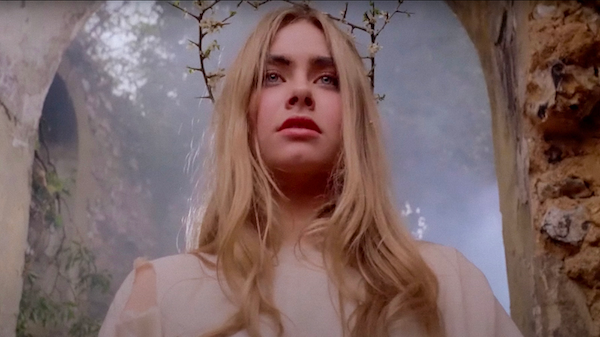Movie review by Greg Carlson
References to more than 200 films and dozens of insights from scholars, programmers, filmmakers, authors and others justify the more than three-hour running time of Miskatonic Institute of Horror Studies founder Kier-La Janisse’s engrossing documentary “Woodlands Dark and Days Bewitched: A History of Folk Horror.” Originally conceived by the director as a much shorter bonus featurette to accompany Severin’s restoration of “The Blood on Satan’s Claw,” the sprawling, near comprehensive overview is a must for horror hounds and cinephiles. Following a 2021 South by Southwest premiere, the film is available as a standalone physical media release. It also anchors Severin’s handsome Blu-ray box set “All the Haunts Be Ours: A Compendium of Folk Horror.”
Divided into chapters, the film begins with an overview of the “unholy trinity” of genre/mode influences. Piers Haggard’s “The Blood on Satan’s Claw,” Michael Reeves’s “Witchfinder General,” and Robin Hardy’s “The Wicker Man” spoke to Vietnam War-era anxieties and powerful anti-authoritarian sentiments. Whether real or imagined, witches and witchcraft as vehicles for the feminist rebuke of the patriarchy set down deep thematic roots. Other core folk horror tropes, like ritual sacrifice and explorations of paganism and the Old Gods as manifested in the pastoral and the agrarian, would go on to inspire future moviemakers.
Determined to accept the largest number of potential titles, Janisse operates with a spirit of inclusiveness that welcomes all kinds of things that might be better (or at least more commonly) categorized in other popular horror subgenres. For example, folk horror isn’t necessarily the first thing that comes to mind when assessing Herschell Gordon Lewis’s “Two Thousand Maniacs” or Alan Parker’s “Angel Heart” or Bernard Rose’s “Candyman,” but Janisse and her interview subjects make a reasonable case for their consideration.
The wide net cast by “Woodlands Dark” snares international films of many types and vintages. Extending the big tent approach, happy listmakers will find entries from Australia, Canada, Czechoslovakia, Iceland, Italy, Japan, Mexico, Norway, Poland, Serbia, the former Soviet Union and others, alongside the heavy presence of material originating in the United Kingdom and the United States. Theatrical features share the conversation with made-for-TV movies and individual episodes of series such as “Doctor Who,” “The Waltons,” “The Twilight Zone,” “Tales From the Darkside,” “Thriller,” and several more.
The sheer breadth of Janisse’s labors means that only a handful of the huge catalog receives the kind of deep dive that many viewers crave. It’s a minor complaint, though, given the expertise that radiates so passionately from the parade of assembled enthusiasts. By the time we reach the end, which lifts up the contributions of Ben Wheatley, Robert Eggers, Ari Aster, and a handful of other contemporary practitioners, Janisse has convincingly shown us the ancestors and origins of “A Field in England,” “The Witch,” and “Midsommar.” By this point, we have been asked to wrestle with the largest definition of folk horror to date. Academic Dawn Keetley offers one of the best summaries: “As our world becomes more urban, global, complex, and virtual, our nostalgia for a life that is more rooted, rural, and embodied increases exponentially.”
